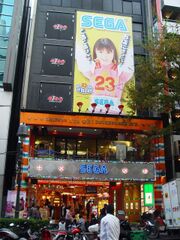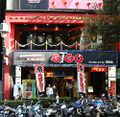Difference between revisions of "Shibuya GiGO"
From Sega Retro
| Line 5: | Line 5: | ||
| name= | | name= | ||
| location=東京都渋谷区道玄坂2丁目6番地16号, Japan | | location=東京都渋谷区道玄坂2丁目6番地16号, Japan | ||
| − | | opened=1999-06-26{{ref|https:// | + | | opened=1999-06-26{{magref|dmjp|1999-22ex|7}} |
| − | + | | closed=2010-03-28{{ref|https://web.archive.org/web/20160326190310/https://anan.sega.jp/lounge_report_03.html}} | |
}} | }} | ||
| − | + | '''Shibuya GiGO''' (渋谷GiGO) is a former [[GiGO]] game center opened by [[Sega]]. Launched in June 1999 and designed to appeal to young women in particuar,{{ref|https://web.archive.org/web/20001025195503/http://www.sega.co.jp/sega/corp/news/nr990526_1.html}} the center saw Sega experiment further with establishing amusement facilities that targeted a wider range of demographics. Despite its status as a flagship venue and the largest arcade in Shibuya,{{ref|https://web.archive.org/web/20100201180355/http://location.sega.jp/loc_web/shibuya_gigo.html}} it later closed in March 2010.{{ref|https://web.archive.org/web/20160326190310/https://anan.sega.jp/lounge_report_03.html}} | |
| + | |||
| + | ==History== | ||
| + | During the late 1980s and early 1990s, progress was made by the Japanese amusement industry in cleaning up arcades/game centers. Alongside rivals like [[Taito]], Sega played a significant part, establishing family-oriented branded chain stores like [[Hi-Tech Land Sega]] and [[Sega World]], in which women's toilets, brighter décor, and smoking zones were introduced.{{ref|https://web.archive.org/web/20201219075548/http://shmuplations.com/akiranagai/}} However, despite further growth with new large scale facilities in the latter part of the 90s, attendance was falling at some, leading to a re-evaluation of the market and the creation of new venue concepts to replace over 200 closing venues.{{fileref|AnnualReport2000_English.pdf|page=14}} Shibuya GiGO, the first GiGO location since the mid 1990s and scheduled to open in late June, was seen to be a part of this.{{fileref|AnnualReport1999_English.pdf|page=11}}{{magref|dmjp|1999-20|7}} | ||
| + | |||
| + | When opened on June 26, 1999 in the "I'm ON!" building in Dogenzaka, Shibuya, Shibuya GiGO was one of Sega's first amusement facilities to outwardly appeal to young women specifically, succeeding the earlier [[Kyoto Joypolis]].{{ref|https://web.archive.org/web/20001005132726/http://www.sega.co.jp/sega/AM-space/sibugi/home.html}}{{ref|https://web.archive.org/web/20210622003617/https://nlab.itmedia.co.jp/games/news/9906/25/news04.html}} The venue was characterised by its distinctive bright pink décor and emphasis on current trends in gaming, including Sega's [[Dreamcast]] console with an official "Dream On!" shop containing a network of 15 playable consoles, and an area dedicated to the then-popular rhythm action games.{{magref|dmjp|1999-22ex|7}} A makeup corner, purikura photo booth area, and neighbouring tenants such as a Claire's Accessories outlet and bars complemented its targeting of women.{{ref|https://web.archive.org/web/20000916132434/http://www.sega.co.jp/sega/AM-space/sibugi/imon.html}} | ||
| + | |||
| + | During the months after its opening, numerous features of the ''[[GameWave]]'' television show were shot on location at the venue. Sega also chose it as one of the three venues in Tokyo to receive the [[Entertainment STAGE net@]] internet cafes when launched in August 2000,{{magref|dmjp|2000-29|9}} though this venture was short-lived and swiftly pulled in October 2001 after poor returns. A [[Studio Sega]]-branded purikura area{{ref|https://web.archive.org/web/20060821225915/http://www.shibuya-gigo.jp/}} and over-20s ''[[MJ4]]'' lounge were later added,{{ref|https://web.archive.org/web/20210610064313/http://www.sega-mj.com/mj4/news/news_20080620.html}}{{ref|https://web.archive.org/web/20210621000037/https://www.shibukei.com/headline/4371/}} and in 2008 it appeared in ''[[428: Fuusa Sareta Shibuya de]]'' for the [[Nintendo Wii]].{{ref|https://web.archive.org/web/20100117131751/https://www.4gamer.net/games/074/G007427/20081125017/}} By March 2010, however, Sega had withdrew from managing the center;{{ref|https://web.archive.org/web/20160326190310/https://anan.sega.jp/lounge_report_03.html}} Shibuya GiGO's former space has more recently been used for an Adores game center and a pachinko parlour.{{ref|https://www.google.com/maps/place/%E6%9D%B1%E4%BA%AC%E9%83%BD%E6%B8%8B%E8%B0%B7%E5%8C%BA%E9%81%93%E7%8E%84%E5%9D%82%EF%BC%92%E4%B8%81%E7%9B%AE%EF%BC%96%E7%95%AA%E5%9C%B0%EF%BC%91%EF%BC%96%E5%8F%B7,+Japan/@35.6592744,139.6986242,3a,75y,170.91h,90t/data=!3m4!1e1!3m2!1sr15lb__Fvz8fwomzIc7W2A!2e0!4m2!3m1!1s0x60188b562a804b11:0x18ae2c7fefc1cc81?sa=X&ved=2ahUKEwixspCTkqrxAhXGBGMBHSb7BOQQxB16BAgGEAI}} | ||
| + | |||
| + | ==Layout== | ||
| + | [[File:Shibuya GiGO 2006.jpg|thumb|right|Shibuya GiGO, 2006]] | ||
| + | Like the preceding six GiGO venues, Shibuya GiGO was an inner city multi-floor game center/entertainment space, originally taking up three floors of the "I'm ON!" building it was situated in and acting as its most significant tenant.{{ref|https://web.archive.org/web/20000916132353/http://www.sega.co.jp/sega/AM-space/sibugi/event.html}} However, when opened, the contents of the floors compared to previous facilities opened under the scheme differed, as a result of it targeting young women in particular.{{ref|https://web.archive.org/web/20000916132300/http://www.sega.co.jp/sega/AM-space/sibugi/floor.html}} | ||
| + | |||
| + | The first floor, originally located on the second level of the building, featured the "Staging Zone" (rhythm games), "Amenity Zone" (photo booths), and "Ladies Zone" (prize games). A "Dreamcast Zone" (official store + free to play consoles) and "Jungle Zone" (featuring ''[[Derby Owners Club]]'') took up the second floor's space, while the third floor was centered around its "Medal Game Zone" and "Powder room" (makeup area).{{ref|https://web.archive.org/web/20000916132300/http://www.sega.co.jp/sega/AM-space/sibugi/floor.html}} | ||
| + | |||
| + | Later additions to Shibuya GiGO included a small amount of games situated on the first and ground floors. In 2000, an [[Entertainment STAGE net@]] internet cafe suite was added to the existing Dreamcast Zone;{{ref|https://web.archive.org/web/20210620185650/https://www.ign.com/articles/2000/09/06/ign-invades-entertainment-stage-net-shibuya}} this was removed months later after the discontinuation of the concept. Other special facilities made added in later years included an over-20s ''[[MJ4]]'' lounge under the name of "Spread".{{ref|https://web.archive.org/web/20210610064313/http://www.sega-mj.com/mj4/news/news_20080620.html}} | ||
==Branding== | ==Branding== | ||
| Line 16: | Line 31: | ||
}} | }} | ||
| − | == | + | ==Artwork== |
<gallery> | <gallery> | ||
| − | + | ShibuyaGiGO logo 1999.png|1999 logo | |
| − | |||
</gallery> | </gallery> | ||
| − | == | + | ==Gallery== |
<gallery> | <gallery> | ||
| − | + | ShibuyaGigo Japan Older.jpg|1999 exterior | |
| + | Staging Zone Shibuya GiGO.jpg|"Staging Zone" | ||
| + | Amenity Zone Shibuya GiGO.jpg|"Amenity Zone" | ||
| + | Ladies Zone Shibuya GiGO.jpg|"Ladies Zone" | ||
| + | Dreamcast Zone Shibuya GiGO.jpg|"Dreamcast Zone" | ||
| + | Jungle Zone Shibuya GiGO.jpg|"Jungle Zone" | ||
| + | Powder Room Shibuya GiGO.jpg|"Powder room" | ||
| + | ShibuyaGigo Japan.jpg|2000s exterior (2007) | ||
| + | 428 Shibuya GiGO.jpg|Photos used in ''428: Fuusa Sareta Shibuya de'' | ||
| + | 428 Shibuya GiGO 2.jpg | ||
| + | 428 Shibuya GiGO 3.jpg | ||
| + | 428 Shibuya GiGO 4.jpg | ||
</gallery> | </gallery> | ||
==Magazine articles== | ==Magazine articles== | ||
{{mainArticle|{{PAGENAME}}/Magazine articles}} | {{mainArticle|{{PAGENAME}}/Magazine articles}} | ||
| + | |||
| + | ==External links== | ||
| + | *[https://web.archive.org/web/20000819172958/http://www.sega.co.jp/sega/AM-space/sibugi/ 2000 sega.jp page] (archived) | ||
| + | *[https://web.archive.org/web/20060821225915/http://www.shibuya-gigo.jp/ 2006 sega.jp page] (archived) | ||
==References== | ==References== | ||
Latest revision as of 21:02, 21 June 2021

|
| Shibuya GiGO |
|---|
| Location: 東京都渋谷区道玄坂2丁目6番地16号, Japan |
| Opened: 1999-06-26[1] |
| Closed: 2010-03-28[2] |
Shibuya GiGO (渋谷GiGO) is a former GiGO game center opened by Sega. Launched in June 1999 and designed to appeal to young women in particuar,[3] the center saw Sega experiment further with establishing amusement facilities that targeted a wider range of demographics. Despite its status as a flagship venue and the largest arcade in Shibuya,[4] it later closed in March 2010.[2]
Contents
History
During the late 1980s and early 1990s, progress was made by the Japanese amusement industry in cleaning up arcades/game centers. Alongside rivals like Taito, Sega played a significant part, establishing family-oriented branded chain stores like Hi-Tech Land Sega and Sega World, in which women's toilets, brighter décor, and smoking zones were introduced.[5] However, despite further growth with new large scale facilities in the latter part of the 90s, attendance was falling at some, leading to a re-evaluation of the market and the creation of new venue concepts to replace over 200 closing venues.[6] Shibuya GiGO, the first GiGO location since the mid 1990s and scheduled to open in late June, was seen to be a part of this.[7][8]
When opened on June 26, 1999 in the "I'm ON!" building in Dogenzaka, Shibuya, Shibuya GiGO was one of Sega's first amusement facilities to outwardly appeal to young women specifically, succeeding the earlier Kyoto Joypolis.[9][10] The venue was characterised by its distinctive bright pink décor and emphasis on current trends in gaming, including Sega's Dreamcast console with an official "Dream On!" shop containing a network of 15 playable consoles, and an area dedicated to the then-popular rhythm action games.[1] A makeup corner, purikura photo booth area, and neighbouring tenants such as a Claire's Accessories outlet and bars complemented its targeting of women.[11]
During the months after its opening, numerous features of the GameWave television show were shot on location at the venue. Sega also chose it as one of the three venues in Tokyo to receive the Entertainment STAGE net@ internet cafes when launched in August 2000,[12] though this venture was short-lived and swiftly pulled in October 2001 after poor returns. A Studio Sega-branded purikura area[13] and over-20s MJ4 lounge were later added,[14][15] and in 2008 it appeared in 428: Fuusa Sareta Shibuya de for the Nintendo Wii.[16] By March 2010, however, Sega had withdrew from managing the center;[2] Shibuya GiGO's former space has more recently been used for an Adores game center and a pachinko parlour.[17]
Layout
Like the preceding six GiGO venues, Shibuya GiGO was an inner city multi-floor game center/entertainment space, originally taking up three floors of the "I'm ON!" building it was situated in and acting as its most significant tenant.[18] However, when opened, the contents of the floors compared to previous facilities opened under the scheme differed, as a result of it targeting young women in particular.[19]
The first floor, originally located on the second level of the building, featured the "Staging Zone" (rhythm games), "Amenity Zone" (photo booths), and "Ladies Zone" (prize games). A "Dreamcast Zone" (official store + free to play consoles) and "Jungle Zone" (featuring Derby Owners Club) took up the second floor's space, while the third floor was centered around its "Medal Game Zone" and "Powder room" (makeup area).[19]
Later additions to Shibuya GiGO included a small amount of games situated on the first and ground floors. In 2000, an Entertainment STAGE net@ internet cafe suite was added to the existing Dreamcast Zone;[20] this was removed months later after the discontinuation of the concept. Other special facilities made added in later years included an over-20s MJ4 lounge under the name of "Spread".[14]
Branding
| Name | Branding | Date |
|---|---|---|
| Shibuya GiGO (渋谷GiGO) | GiGO | 1999-06-26 |
| Closed | 2010-03-28 | |
Artwork
Gallery
Magazine articles
- Main article: Shibuya GiGO/Magazine articles.
External links
- 2000 sega.jp page (archived)
- 2006 sega.jp page (archived)
References
- ↑ 1.0 1.1 Dreamcast Magazine, "1999-22 extra (1999-07-23ex)" (JP; 1999-07-09), page 7
- ↑ 2.0 2.1 2.2 https://anan.sega.jp/lounge_report_03.html (Wayback Machine: 2016-03-26 19:03)
- ↑ http://www.sega.co.jp/sega/corp/news/nr990526_1.html (Wayback Machine: 2000-10-25 19:55)
- ↑ http://location.sega.jp/loc_web/shibuya_gigo.html (Wayback Machine: 2010-02-01 18:03)
- ↑ http://shmuplations.com/akiranagai/ (Wayback Machine: 2020-12-19 07:55)
- ↑ File:AnnualReport2000_English.pdf, page 14
- ↑ File:AnnualReport1999_English.pdf, page 11
- ↑ Dreamcast Magazine, "1999-20 (1999-06-25)" (JP; 1999-06-11), page 7
- ↑ http://www.sega.co.jp/sega/AM-space/sibugi/home.html (Wayback Machine: 2000-10-05 13:27)
- ↑ https://nlab.itmedia.co.jp/games/news/9906/25/news04.html (Wayback Machine: 2021-06-22 00:36)
- ↑ http://www.sega.co.jp/sega/AM-space/sibugi/imon.html (Wayback Machine: 2000-09-16 13:24)
- ↑ Dreamcast Magazine, "2000-29 (2000-09-08,09-15)" (JP; 2000-08-25), page 9
- ↑ http://www.shibuya-gigo.jp/ (Wayback Machine: 2006-08-21 22:59)
- ↑ 14.0 14.1 http://www.sega-mj.com/mj4/news/news_20080620.html (Wayback Machine: 2021-06-10 06:43)
- ↑ https://www.shibukei.com/headline/4371/ (Wayback Machine: 2021-06-21 00:00)
- ↑ https://www.4gamer.net/games/074/G007427/20081125017/ (Wayback Machine: 2010-01-17 13:17)
- ↑ [ ]
- ↑ http://www.sega.co.jp/sega/AM-space/sibugi/event.html (Wayback Machine: 2000-09-16 13:23)
- ↑ 19.0 19.1 http://www.sega.co.jp/sega/AM-space/sibugi/floor.html (Wayback Machine: 2000-09-16 13:23)
- ↑ https://www.ign.com/articles/2000/09/06/ign-invades-entertainment-stage-net-shibuya (Wayback Machine: 2021-06-20 18:56)
| GiGO venues in Japan |
|---|
| Akihabara | Gifu | Hiroshima | Ikebukuro | Roppongi | Shibuya | Shinsaibashi | Tenjin |













